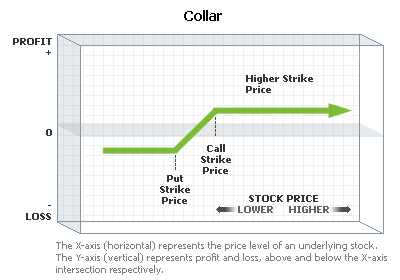 From the Options Industry Council:
From the Options Industry Council:
The results of a new study examining the use of options in a collar strategy (both active and passive implementations) on the PowerShares QQQ™ exchange-traded fund (ETF) show it provides superior returns to the traditional buy and hold strategy while reducing risk by almost 65%.
The Options Industry Council (OIC) is pleased to note the study reaffirms the risk management potential of equity options, finding that during the entire 10-year study period, including the sub-periods around the tech bubble and credit crisis, collars significantly outperformed the QQQ, providing much needed capital protection.
 “Loosening Your Collar: Alternative Implementations of QQQ Collars,” by Edward Szado and Thomas Schneeweis, looked at data from March 1999 to May 2009. It concluded that over the entire 122 month period the passive collar returned almost 150%, while the QQQ lost one-third of its value. The active collar outperformed both strategies and returned more than 200%.
“Loosening Your Collar: Alternative Implementations of QQQ Collars,” by Edward Szado and Thomas Schneeweis, looked at data from March 1999 to May 2009. It concluded that over the entire 122 month period the passive collar returned almost 150%, while the QQQ lost one-third of its value. The active collar outperformed both strategies and returned more than 200%.
Additionally, the study simulated a collar on a small-cap mutual fund. The return of the active mutual fund collar was four times the return of the fund, while the standard deviation was about one-third lower. The study was conducted by the Isenberg School of Management’s Center for International Securities and Derivatives Markets (CISDM) at the University of Massachusetts.
Typically, you want to employ a collar to protect a dividend-paying stock from losing value. We employed this strategy successfully in our last $100K Virtual Portfolio with KMP, who pay a healthy 7.6% dividend but had fallen 35% in 6 months in March. As we were re-entering the position back at $40 (with a 10% dividend), we were happy to be in it just for the premiums.
The study makes for a very interesting read. We do not employ full collars very often but they are a very useful strategy to know as you can "lock down" your positions when the markets get rough and it's also a great way to vacation-proof your virtual portfolio without having to alter your existing positions. Also, as noted in the study, an active management approach – like the one we employ in our buy/writes (rolling the short positions along) leads to the greatest benefits over time. As the OIC says about the strategy:
This strategy offers the stock protection of a put. However, in return for accepting a limited upside profit potential on his underlying shares (to the call's strike price), the investor writes a call contract. Because the premium received from writing the call can offset the cost of the put, the investor is obtaining downside put protection at a smaller net cost than the cost of the put alone. In some cases, depending on the strike prices and the expiration month chosen, the premium received from writing the call will be more than the cost of the put. In other words, the combination can sometimes be established for a net credit – the investor receives cash for establishing the position. The investor keeps the cash credit, regardless of the price of the underlying stock when the options expire. Until the investor either exercises his put and sells the underlying stock, or is assigned an exercise notice on the written call and is obligated to sell his stock, all rights of stock ownership are retained. See both Protective Put and Covered Call strategies presented earlier in this section of the site.
Risk vs. Reward
This example assumes an accrued profit from the investor's underlying shares at the time the call and put positions are established, and that this unrealized profit is being protected on the downside by the long put. Therefore, discussion of maximum loss does not apply. Rather, in evaluating profit and/or loss below, bear in mind the underlying stock's purchase price (or cost basis). Compare that to the net price received at expiration on the downside from exercising the put and selling the underlying shares, or the net sale price of the stock on the upside if assigned on the written call option. This example also assumes that when the combined position is established, both the written call and purchased put are out-of-the-money.
|
Net Upside Stock Sale Price if Assigned on the Written Call: |
|
Call's Strike Price + Net Credit Received for Combination |
|
Net Downside Stock Sale Price if Exercising the Long Put: |
|
Put's Strike Price + Net Credit Received for Combination or Put's Strike Price – Net Debit Paid for Combination |
If the underlying stock price is between the strike prices of the call and put when the options expire, both options will generally expire with no value. In this case, the investor will lose the entire net premium paid when establishing the combination, or keep the entire net cash credit received when establishing the combination. Balance either result with the underlying stock profits accrued when the spread was established.


